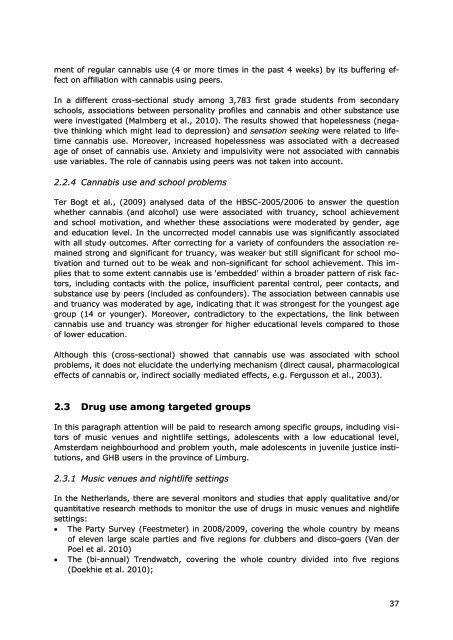The Netherlands Drug Situation 2010 - Trimbos-instituut
The Netherlands Drug Situation 2010 - Trimbos-instituut
The Netherlands Drug Situation 2010 - Trimbos-instituut
You also want an ePaper? Increase the reach of your titles
YUMPU automatically turns print PDFs into web optimized ePapers that Google loves.
ment of regular cannabis use (4 or more times in the past 4 weeks) by its buffering effecton affiliation with cannabis using peers.In a different cross-sectional study among 3,783 first grade students from secondaryschools, associations between personality profiles and cannabis and other substance usewere investigated (Malmberg et al., <strong>2010</strong>). <strong>The</strong> results showed that hopelessness (negativethinking which might lead to depression) and sensation seeking were related to lifetimecannabis use. Moreover, increased hopelessness was associated with a decreasedage of onset of cannabis use. Anxiety and impulsivity were not associated with cannabisuse variables. <strong>The</strong> role of cannabis using peers was not taken into account.2.2.4 Cannabis use and school problemsTer Bogt et al., (2009) analysed data of the HBSC-2005/2006 to answer the questionwhether cannabis (and alcohol) use were associated with truancy, school achievementand school motivation, and whether these associations were moderated by gender, ageand education level. In the uncorrected model cannabis use was significantly associatedwith all study outcomes. After correcting for a variety of confounders the association remainedstrong and significant for truancy, was weaker but still significant for school motivationand turned out to be weak and non-significant for school achievement. This impliesthat to some extent cannabis use is 'embedded' within a broader pattern of risk factors,including contacts with the police, insufficient parental control, peer contacts, andsubstance use by peers (included as confounders). <strong>The</strong> association between cannabis useand truancy was moderated by age, indicating that it was strongest for the youngest agegroup (14 or younger). Moreover, contradictory to the expectations, the link betweencannabis use and truancy was stronger for higher educational levels compared to thoseof lower education.Although this (cross-sectional) showed that cannabis use was associated with schoolproblems, it does not elucidate the underlying mechanism (direct causal, pharmacologicaleffects of cannabis or, indirect socially mediated effects, e.g. Fergusson et al., 2003).2.3 <strong>Drug</strong> use among targeted groupsIn this paragraph attention will be paid to research among specific groups, including visitorsof music venues and nightlife settings, adolescents with a low educational level,Amsterdam neighbourhood and problem youth, male adolescents in juvenile justice institutions,and GHB users in the province of Limburg.2.3.1 Music venues and nightlife settingsIn the <strong>Netherlands</strong>, there are several monitors and studies that apply qualitative and/orquantitative research methods to monitor the use of drugs in music venues and nightlifesettings: <strong>The</strong> Party Survey (Feestmeter) in 2008/2009, covering the whole country by meansof eleven large scale parties and five regions for clubbers and disco-goers (Van derPoel et al. <strong>2010</strong>) <strong>The</strong> (bi-annual) Trendwatch, covering the whole country divided into five regions(Doekhie et al. <strong>2010</strong>);37




